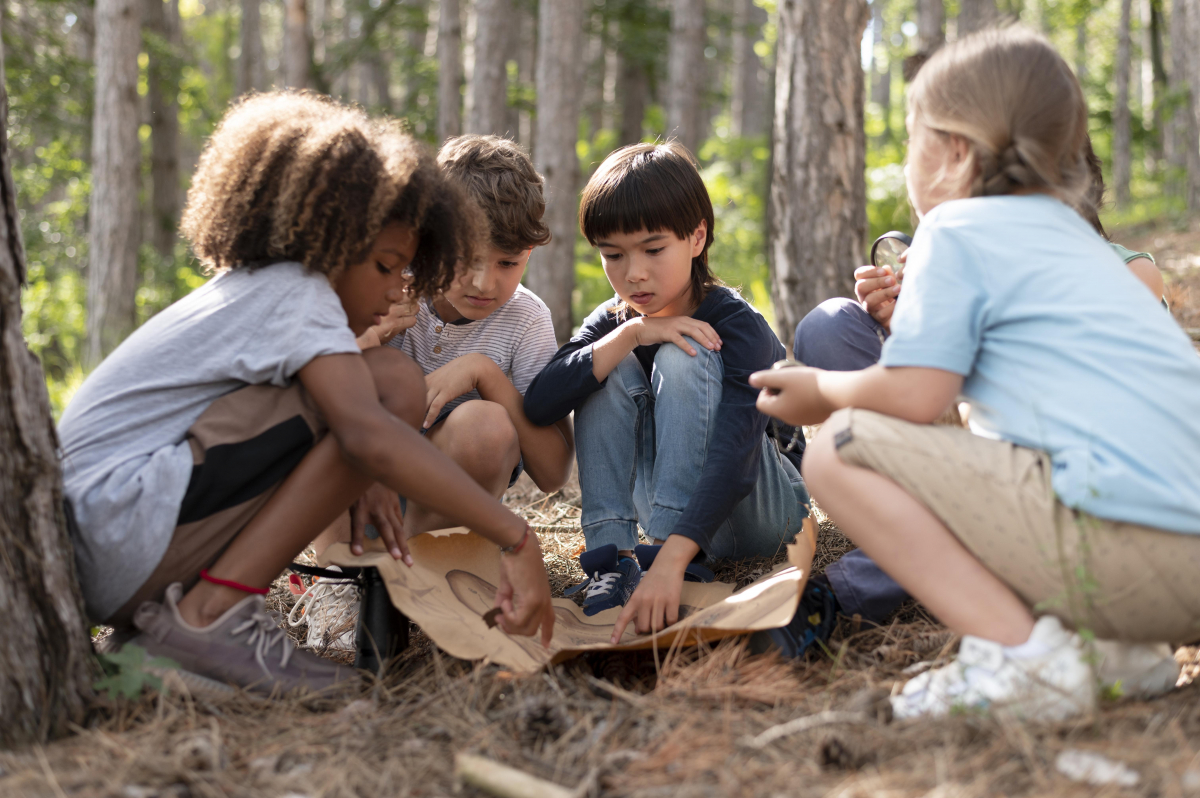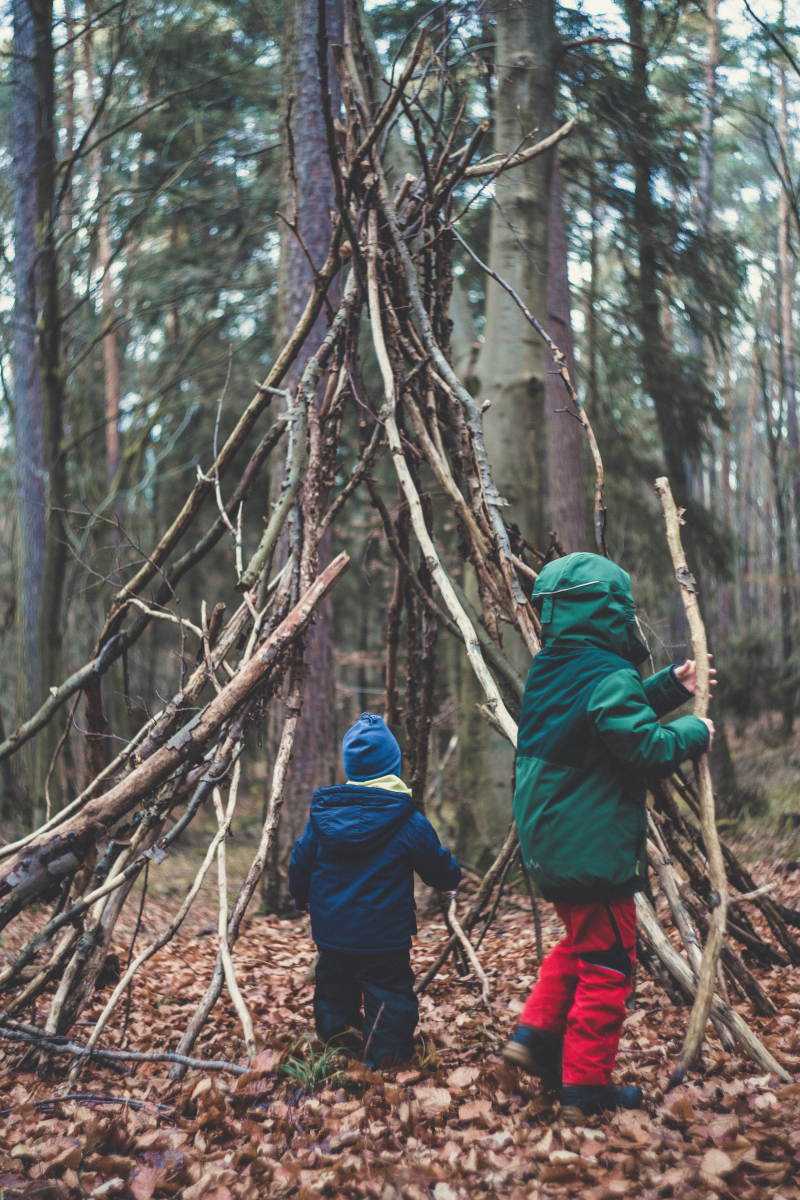 Why we should step back and let the story in.
Why we should step back and let the story in.
Storytelling has long been regarded as the most important form of communication, and may even be the reason language developed in the first place! Stories evoke emotions. They make us inspired, laugh, cry, and get angry too. Because of this, we see high engagement and strong motivation from children during story-based activities.
When a story is used to guide an activity, two things happen. Firstly, the story does the important work of engaging and motivating children. Secondly, and consequently, this allows the adults leading the activity to take a step back, enabling the children to take the lead[1] and in turn gain valuable social and emotional skills such as emotional regulation, problem-solving, cooperation, confidence, and empathy[2]; as well as sharpen critical thinking skills[3] and enhance higher reasoning capabilities.
The suggested activities in this resource are story-based, child-directed, and provide group success. Incorporating these core aspects will allow children to benefit fully from the activities in this resource. Activities are designed for small groups (5-10) but can be adapted for any size. The “Book to Hook” can be used as an introduction to help students get into the activity. The activities in this resource nurture all the Heart-Mind Qualities.
 Activity #1: Save Your Leaders
Activity #1: Save Your Leaders
Target Skill: Group problem solving and building positive relationships with others
Suggested Length: 40mins - 1.5hrs
A Book to Hook: The Barnabus Project by the Fan Brothers
Adult Character(s): Anything that is fun for the kids: a silly clown, a magical wizard, or just someone who talks really fast! Be creative, have fun, and dress up! (Avoid characters that are overly sad or mean).
Story: Children find a note that says “Ha ha ha, all of your leaders have been put under a personality warp spell! The leaders are no longer themselves and only you can save them! You must work together to complete each task to earn letters. The letters can then be unscrambled into a secret word that will release them from the spell! All members of the group must be present to complete each task. Your new leader will lead you to each task and will inform you when a task is complete or not. Good Luck”!
Materials: Paper, markers, materials for the chosen tasks, costumes for adults
Directions: A large variety of tasks can be used, but here are some examples.
- Rebus Puzzles - solve the puzzles to get your letter.
- Laugh out loud - make your leader laugh any way you can (the adult can decide to fake laugh if the task is taking way too long).
- Find 5 things hidden around the area.
- Include a task that is curriculum relevant/related - e.g. math problems, answer science questions or perform physical education skills.
- Unscramble the letters. Then say the word out loud to break the spell. The adult(s) slowly come out of character, dizzy and confused. Have fun!
 Activity #2: Shelter Quest
Activity #2: Shelter Quest
Target Skill: Building community and friendships
Suggested Length: 45 min-2 hrs
A Book to Hook: Green City by Allan Drummond.
Character(s): The Grand Wazoo (a wise old man of the forest), shopkeeper
Story: The Grand Wazoo explains “I have a problem that I hope you can help me with. Many years ago there was a community of Greenies that lived in these parts. They were driven off the land by the “Great Flood” but are returning tomorrow! I promised them that I would have a community built for them to live in by the time they arrived but I forgot until now! Please hurry and build a community for the Greenies! I have found all their lost currency (show them a jar of dried beans). For the next 30 minutes you will start building the shelters. Then beans will be handed out so you can buy more materials when the next shipment of supplies arrives. Good luck and happy building”.
Materials: Rope, string, tarps, blankets, cloth, sticks, cardboard, costumes, decorations.
Directions: Children form their own groups and the Grand Wazoo hands out the starting materials (rope, cloth, blankets, tarps). Children build shelters and use beans to buy materials from the shopkeeper after the shipment arrives. The Grand Wazoo can also act as the shopkeeper if no other adults are available. Have fun haggling with the kids for materials. **It is important that there is time to build before the beans are handed out and the shipment arrives. This gives the children some time to focus on building instead of buying and decorating. Allow time near the end for each group to share what they have built. The Grand Wazoo should circulate and observe but not get too involved with the children’s creations. The children must leave the area before the Greenies arrive!
 Activity #3: The Stepping Stones Trail
Activity #3: The Stepping Stones Trail
Target Skill: Emotional regulation, coping with frustration, team work
Suggested Length: 40mins
A Book to Hook: The Thing That Lou Couldn’t Do by Ashley Spires.
Adult character: Wizard
Story: The Wizard says, “Welcome to the land of Lavadenia! The land of Lavendia is covered in molten lava. Only the stepping stones trail is safe. Stepping on anything else will cause instant blindness and you will be returned back to the beginning. Your task is for your entire group to travel across the stepping stones trail to the safety of the other side. I, Wizard _____ am your guide through this land, but not your helper. You may ask one group question along the way but it must be decided upon by consensus (this means you all must agree on the question). The group must come up with a group name and cheer before starting. Safe travels!”
Materials: Blindfolds, wizard costume, materials to make a stepping stones trail (this is created by the adult beforehand and can range from simple cardboard platforms secured to the ground to logs and rocks). The trail should be designed with easier and more challenging parts.
Directions: If a child steps into the lava, the wizard guides them back to the beginning where they are blindfolded. More than one child in the group may be blindfolded at a time. To complete the task, the children who cross the safely must return to the start and guide their blindfolded teammates across the stepping stones trail. When children try to ask questions, the wizard can answer “is that your one group question?”. This strategy limits the number of questions asked and decreases their interaction with the adult while increasing their interaction as a group. The stepping stones trail activity is designed to encourage physical helpfulness such as holding hands and helping each other balance.
**Consider safety as objects can wobble, and children can become off balance when wearing a blindfold.
A recent research study found that the children of parents who stepped in more often to provide instructions displayed more difficulty regulating their behavior and emotions.
When adults provide a safe environment while allowing children to take the lead, those children gain valuable skills in emotional regulation, problem solving and confidence building.
Uri Hasson, a neuroscientist, has found that stories activate areas in the brain that turn the story into their own idea and experience. This means that when children use their imaginations and act out an adventure, become an Olympic athlete, or pretend to be someone 10 years older, they are putting themselves into someone else's shoes, or, practicing empathy.
Story develops children’s ability to use higher-order thinking skills, such as analyzing, critical and creative thinking. It also develops their social and emotional skills, such as turn-taking, respect for the views of others and empathy.
Lani Peterson states “Through story listening, we gain new perspectives and a better understanding of the world around us. We challenge and expand our own understanding by exploring how others see and understand the world through their lens”.